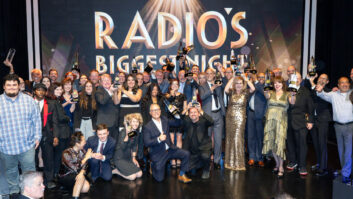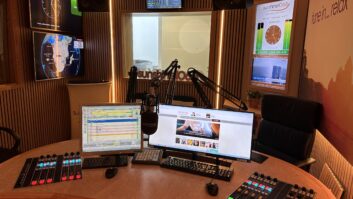The AirTools 6200 is a single rack space dual digital voice processor.
(click thumbnail)The AirTools 6200 is a single rack space dual digital voice processor.Considering the popularity of the venerable Symetrix 528E and 422, and evolution into DSP technology inherent in the Symetrix 628, I suspect Symetrix thought hard about where to take its next generation of microphone processor. With a portfolio of great-sounding and affordable equipment, perhaps making one that is even more flexible was the next big step. The AirTools 6200 by Symetrix is designed to meet a myriad of needs.
The AirTools 6200 is a single rack space dual digital voice processor that can act as two separate units – electronically, if not physically – in the “dual mono” setting, or as an interactive stereo processor. The rear features two analog inputs, two analog outputs, as well as two AES outputs (configurable).
AES input is available by way of a HomerLink CAT-5 connector on the rear panel. Symetrix offers the accessory model number 810HLSY adapter cable 18-inch AES (XLR)-to-HomerLink cable for digital audio or sync input into the 6200.
Control by Designer
The building blocks of the 6200’s DSP signal chain are recognizable via the 6200’s Designer software, compatible with most post-Windows 98 PCs. The limitations in navigating through a menu of settings using a rotary encoder, a couple of momentary switches and a small blue LCD display as found on the 6200’s face are overcome with Designer.
You can control the 6200 via a LAN (i.e., switch), direct via USB or RS-232; handy for making adjustments outside of the studio, perhaps even in an environment that’s geared to better critical listening. When you see the graphic interface that Designer offers, you’ll understand how easy it is to modify settings and have before you a well thought out representation of your signal paths. In this day of waveform editing and laptop studios, most will feel at home here.
The signal flow through the dual processor is shown in the top half of the main screen as block diagrams for each path, or “program,” as Symetrix has chosen to call them. By clicking on any of the displayed building blocks – Symmetry, Hi-Pass filter, De-esser, Parametric EQ, Shelving Filter, Compressor/Expander and Low-Pass Filter – you open up the lower portion of your screen to a graphic of settings along with slide controllers and tabs that select various choices, such as “dB/octave” or “bypass.”
Each stage can be turned on or off independently. Various frequencies and amplitudes can be modified by sliding virtual pots, direct entry of numbers into windows, or by clicking on points in the graph itself and dragging them to desired positions. Input and output levels are adjusted using controls, and metering, on the left and right sides of the screen in a logical fashion.
When selecting the stereo mode, the settings of Program One are copied to Program Two. The 6200 can then be used as a stereo program processor. The mic pre-amplifier stage can handle signals from as low as -80 dBv up to peaks of +24 dBu, giving it a versatile range of input capability. In the dual mono mode, two separate microphones can each be sweetened accordingly, even in different rooms.
Some knowledge of audio basics will be helpful for making good choices in tailoring sound; the 6200’s manual offers some advice here. Filters can be selected for various slopes: 6, 12, 18 or 24 dB/octaves, along with “peak” versions for a sharper response. A four-band parametric EQ can boost or cut as expected; the DSP’s group delay advantages come to mind.
The Shelving Filter provides an easy-to-use, general EQ feature that can, for instance, cut rumble. Dynamic range is controlled by the Compressor/Expander function, which might reinforce a voice that is simply too variant in its proximity to the mic capsule. If you like your new settings, be sure to save them. If you dislike the changes, blow them out and start from scratch. The 6200 encourages the user to “play.”
The sound quality was certainly on par with its lineage, if not better. The amount of flexibility available here may be too much for some applications, but it’s good to know you have it at your disposal, and you don’t lose anything by having them around. The signal is modified by complex algorithms as opposed to routing through multiple analog stages, which can add noise and various distortion products.
The 6200 offers 256 memory locations, which will save levels for the various stages, including inputs and outputs. You can save settings for one Program path alone, or two for a stereo application. Each location is named with up to 20 characters, so each talent can have their own individual setting easily recalled.
In addition, the 6200 can be set up to respond to MIDI commands via the Air Tools RC-1 MIDI controller. Hardwired pinouts allow for an old-fashioned mechanical bypass switch to be employed should this be desired, and up to two parameters can be programmed to be controlled by 10 k-ohm analog pots. The AES output can interface with consoles as a 1/2 dual mono pair, as opposed to stereo AES. Splitting the different Programs to different console inputs is easy.
To accommodate an interface to Symetrix’s HomerLink system, which is designed to transmit four mono-bidirectional AES audio channels to devices up to 100 meters apart over CAT-5 cable, the 6200 contains an RJ-45 designed for use as a HomerLink output or sync input. In addition, TC89 or TC90 time code can be fed to the 6200 to drive the unit’s real-time clock.
Charles Dubé is chief engineer at WFCR(FM), Amherst, Mass.








